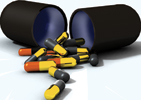

In pharmaceutical processes, temperature is one of the most frequently measured physical parameters and depending on the drug to be produced more than 50% of measuring points are temperature instruments. For example, the growth of cells during fermentation depends significantly on the process temperature. If the temperature is too low, the gain is limited; if it is too high, the cells may die. Therefore, it is important that the temperature is measured with high accuracy at the quality-relevant measuring points.
Regular calibration is essential
In order to guarantee that the accuracy of the measurements remains constant and does not differ, the measuring instruments must be calibrated at regular intervals. The instrument is compared to a reference standard and it is evaluated whether the measuring deviation of the test item is within a tolerable range. How often an instrument is calibrated depends on how far the measurement affects the quality and safety of the production process. Calibration intervals can be up to two years, but for critical processes, they can be considerably shorter. In extreme cases, the measuring instrument is calibrated after each batch.
Pharmaceutical manufacturers must observe the requirements and regulations of the different authorities. The Food and Drug Administration (FDA) plays an important role. The agency within the U.S. Department of Health and Human Services monitors hygiene risks and the quality standards of the drug manufacturers. Principles and guidelines for the safe production and for compliance with the quality standards arise from the European GMP regulations. The essence of the regulations for measuring instruments is that they must not have any negative impact on the quality and safety of the processes and that they consequently have to be calibrated at regular intervals.
Therefore, the electrical thermometers developed by WIKA are all designed in such a way that they can easily be calibrated on site. The thermowell stays in the process and keeps the process closed so that it is not contaminated from outside. The connection head can be pulled out of the thermowell together with the measuring insert and it can be calibrated directly on site at the measuring point by means of an appropriate WIKA dry well calibrator. This makes it possible to calibrate the resistance thermometer (the sensor, the temperature transmitter and the measuring line to the control system including the cable connections) together with the whole measuring chain, i.e. without having to disconnect the electrical connections. A precondition for this is a suitable control system, which enables an on-site calibration. If such a control system is available, the measuring instruments can be calibrated quickly and without much effort directly in the plant. This saves the plant manager the separate calibration of electrical line and sensor as well as the time-consuming insertion and removal of the measuring instruments into/from the clean rooms. Additionally, the number of replacement sensors is kept low. This maximises the availability of the plant and at the same time minimises the costs and the deployment of personnel.
Hygienic design
Another aspect of safe and reliable temperature measurement is hygienic design. The FDA, as control authority for pharmaceutical manufacturers, does not provide any standards for this. Rather it refers to compliance with the standards provided by 3-A Sanitary Standards Inc. In the standard for the sensors and sensor fittings and connections, important criteria are defined concerning the materials, the surfaces and the design of the measuring instruments and sensors. The compliance with the standards is checked by independent certified evaluators in a so called Third Party Verification (TPV). The TR-22 resistance thermometer and the compact TR-21 temperature sensor developed by WIKA are 3-A marked based on a third party verification for conformance to the standard 74-03.
The thermowell for orbital welding recently developed by WIKA has been highlighted for outstanding design. By means of this thermowell, a temperature measuring point can be integrated optimally and without having to use any sealing into sterile pipeline systems. Regarding the measurement, the measuring point is influenced only very little by the ambient temperature, even in naked pipelines as found in clean rooms. The sensor registers the temperature right at the core of the flowing medium and is not influenced by the cooler surface of the pipeline as is the case with surface sensors, for example.
Thanks to the patented design, the flow of the medium is kept optimal. Dead spaces, leading to deposits and cleaning difficulties, are avoided. Thus, electrical resistance thermometers with optimal hygienic design that can be calibrated easily on site are available from WIKA to the operators of pharmaceutical plants.
| Tel: | +27 11 621 0000 |
| Email: | [email protected] |
| www: | www.wika.co.za |
| Articles: | More information and articles about WIKA Instruments |
© Technews Publishing (Pty) Ltd | All Rights Reserved